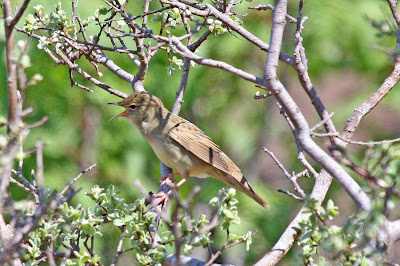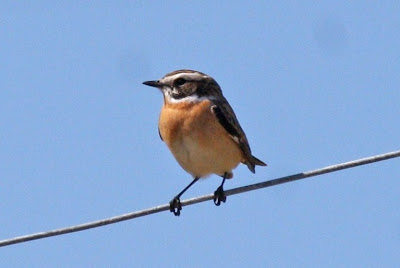The new House Martins are starting their nest on the east side of the farm steading.
After this shot, I roughed up this part of the wall with mortar and mud because from past experience, I know their nests will not stick to this shiny exterior paint. There is a danger the lime will burn their feet or bills but it worked last year so it is worth the risk.
This Robin has been fledged at least 11 days.
A Mountain Hare was on the east side of Treshnish wood.
Moths in the daytime are always more beautiful. This is Silver-ground Carpet
I found a new spot nearby with 2 Broad-leaved Helleborine plants next to 3 Narrow-leaved Helleborine plants
At the spot I found last week the flowering Narrow-leaved Helleborine plant is now fruiting
and there were 3 vegetative plants nearby.
There was Common Cow-wheat there
The Guelder-rose took a bashing in last weeks gale.
30th: Good news today. The House Martins are back. There are at least 5 birds and hopefully at least 1 more pair will join the resident pair which bred last year.
This is presumably the old pair and in the top photo it looks like they are copulating
These are the new birds looking for a good nest-site
A Short-eared Owl was soaring above Treshnish House but I wanted to concentrate on the Mouse Martins (which may not even be here tomorrow) so the photos are not great.
A group of Bullfinches was near Treshnish Old Schoolhouse and at least 2 Siskins were in Treshnish wood (the first for several weeks).
Usual suspects:
Starling at the cowbarn
and a Buzzard being mobbed by the Common Gulls and a Curlew above Treshnish House.
The drop in the wind allowed the first butterflies for weeks (Green-veined White and a possible Red Admiral) and my first Blue-tailed Damselfly near the Ensay Burn owl box. This is 4 days after my previous earliest record (which was also the earliest for the vice-county), so bang on time.
This appears to be the immature form rufescens

29th: There was a Peregrine at Lainne Sgeir, Calgary
where the Shelduck pair have now only one chick. The female Eider at Calgary beach is still not sitting on eggs. There was a male Bullfinch at Treshnish Old Schoolhouse.
This Shag near Calgary beach looks like it is in real trouble. I would have thought Shags would have been ok in the gale.
Usual suspects:
Gannet
(it wasn't until I started taking photos of Gannets that I noticed how they twist their head's round and back as they dive)

Wheatear
Buzzard
29th: I received some nice images from guest Mike Tomlin who rediscovered the Tawny Owls in the 'Barn Owl box' (see 10th). I have yet to get a good Raven and Heron photograph but Mike has managed it.


and I like this shot of Golden Plovers at Caliach on 8th May.

He took this shot of a Great Northern Diver on the 14th at Loch Scridain

There is another image on his 'Wildlife photos of guests' link on the right.
28th: Tawny Owl heard making the 'ooooh' call at night in Treshnish wood.
27th: geese heard below Treshnish wood.
26th: I have been worried about our Swallows being able to feed with these constant winds, In one spot in the wood I could see they had found a flock of insects and thought 'Ah so they are managing' but a few seconds later I came across one sitting on the path. I picked it up and started to think how I could feed it (moth trap?) but thought I could try a suet ball. But by the time I had crumbled up some of the suet-ball it had died! I hope this is just nature sorting out the old and weak because it is pretty awful to think that this bird has flown thousand of miles to come for out summer weather and get hit by this.
I had a brief view of a possible House Martin at Treshnish House and 1 Golden Eagle flew west over Treshnish wood.
There were 2 geese over Treshnish wood. I presume they were greylags but one is much larger than the other so I presume it is a pair.
There was a male Hen Harrier over Langamull wood and some fantastic Hazel Gloves fungus near Dùn Mhadaidh near there.
Went for walk to see how the Treshnish Narrow-leaved Helleborines are doing. They seem OK although the flowers of the only one in flower is looking a bit brown. The third one has not emerged yet and may not but it was very late last year. The Broad-leaved Helleborines are fine too but after the Narrow-leaved being eaten and the wind I have the 2 new ones protected with plastic pots!
25th: I was surprised to learn that Sabine's Gull has never been recorded in the spring in Argyll and the previous earliest records (before the recent records) was of 2 birds at the end of July. Although it is rare on Mull it is given as a scarce autumn migrant in the recent Birds of Argyll (Argyll Bird Club) and interestingly the first record for Argyll was shot at Loch Spelve, Mull on 7th or 8th September 1883.
The Red-necked Phalarope at Killiechronan was also on an exceptional date presumably due to the westerly gale. It is given in Argyll Birds as a 'very rare but regular breeding species on Tiree until 1992 and 1999-2000. Very rare occasional passage migrant elsewhere' and later states 'there are no spring records in Argyll away from the breeding areas.'
The Narrow-leaved Helleborines in Calgary Art In Nature walk have been devastated by the storm. We could find only one with flowers and the ends of the leaves of the few we could find were burnt.
24th: 1 Sabine's Gull was still on Calgary beach


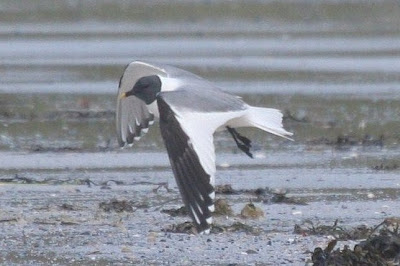

unsurprisingly after this (below) it flew out to sea for a short while and has not been seen since
There were also at least 2 Arctic Terns
The Shelduck at Lainne Sgeir, Calgary still have their 2 ducklings and there was a female Eider at Calgary beach with the drake nearby. I presume she hasn't laid eggs yet.
There was a pair of Red-throated Divers in Calgary bay which approached the beach.
A Golden Eagle was seen (far off) to be mobbed by a Short-eared Owl from Reudle Schoolhouse and there were 6 Greylags near the Treshnish headland walk car-park and a male Hen Harrier flew beside Treshnish Old Schoolhouse.
Usual suspects: Sand Martins at Calgary beach
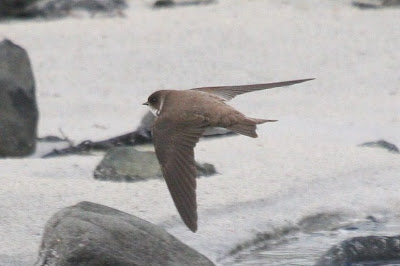

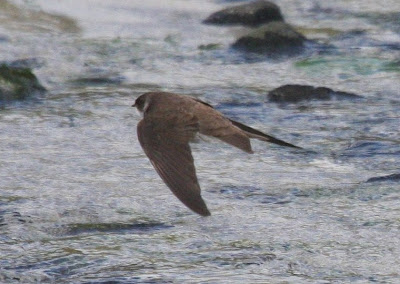
Wheatear
23rd: There was 1 Sabine's Gulls in Calgary bay and another on the beach (my first on Mull) with 2 first summer Black-headed Gulls. There were also 3 dark phase Arctic Skuas and about 10 Arctic Terns.
Arctic Skua 1

and 2
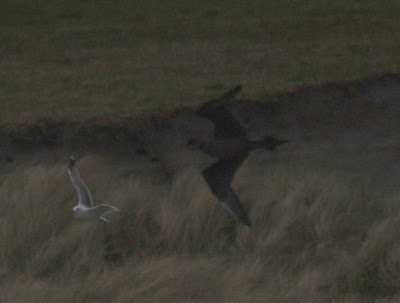
Arctic Tern
and first summer Black-headed Gulls
A Red-necked Phalarope was seen at Killiechronan, see (Mullbirds) for fantastic images of that and another Sabine's Gull.
22nd: A Peregrine made a fast dive towards the Common Gull colony above Treshnish wood. There was a recently fledged Wheatear at Treshnish Point and a Meadow Pipit nest with eggs at Ensay Burn mouth.
This Fulmar has definitely not laid yet. She spent some time throwing dirt out of the ledge

and seemed to be rubbing herself against the walls presumably to clean up any loose rocks.
Usual suspects:
Oystercatcher
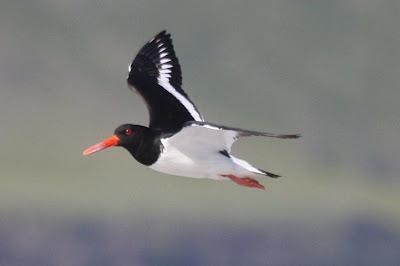
Gannet.

20th: There were 2 Canada Geese near Ensay Burn mouth (Ensay side).
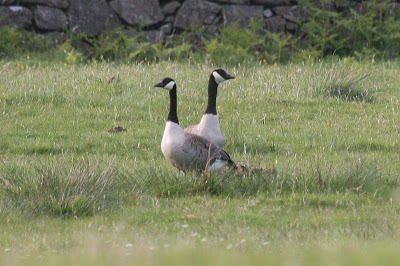
I have only seen this species here once before on 24th May 2008 (which is only 4 days difference). Malcolm Ward saw 5 at Haunn on 4th April this year.
I promise to eventually get a better Cuckoo shot than this.
Newly fledged Robins were calling everywhere but can be amazingly hard to spot
even when out in the open

A Mountain Hare by Ensay Burn was too fast, this was slower
I went to look at a nearby Narrow-leaved Helleborine which I discovered very late last year on 6th of October. It was so late last year I was surprised to see it flowering already and a bit weather beaten. It was exciting to find not only the 1 but 2 flowering and 2 small young vegetative plants. One of the flowering plants looks like it could set seed.
The juvenile can already feed a little

2 goosander species flew up Ensay Burn and the Greylags could be heard near the graveyard. No Chiffchaffs heard since the 14th.
Usual suspects:
Lesser Redpoll


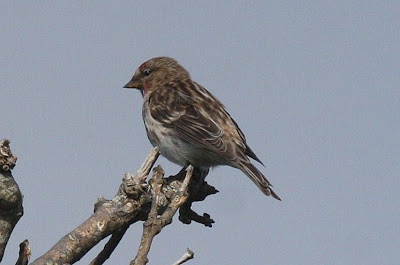
Gannet
A Mountain Hare was in the meadow below Treshnish House.
An Orange-tip butterfly was seen briefly on road through Treshnish wood.
Fantastic news was a new Narrow-leaved Helleborine plant flowering in Treshnish wood. It was below some conifers, the last place I would have expected it. Over the years I have combed the wood for this species including the nearby hillside so this was a big surprise! There are 3 known plant at Treshnish and 1 nearby.
Northern Marsh-orchid is flowering on the coastal strip below Treshnish house.
18th: There were 2 pairs of Greylags at Ensay Burn mouth. Some shearwaters with the Manx Sheawater looked to large and dark for Manx Shearwater but I must have been mistaken because other shearwaters are rare in spring and I only had my camera and no telescope
At 11.30pm a Tawny Owl was heard in Treshnish wood (fairly quiet qwik call)
Usual suspects included:
Gannet
Kittiwake
and for comparison Common Gull
Rock Pipit parent with food for fledglings
The 2 Broad-leaved Helleborine plants are emerging (one is right beside a mini rock fall but it has survived). This plant is rare on Mull although not so rare elsewhere in the UK. There are good numbers beside the path on the Tobermory light-house walk. They are in flower in mid summer but I have been told by the county recorder to ask people to keep to the path from which it is very easy to see this beautiful orchid.
A plant beside the expected second Narrow-leaved Helleborine near Treshnish Old Schoolhouse is just emerging but the leaves look quite broad so I think it a new Broad-leaved Helleborine plant. The first Narrow-leaved Helleborine is still in leaf but the stem has been nibbled in half.
The Common Twayblade has finally started flowering and what looks like a Greater Butterfly-orchid is in bud below Treshnish House.
17th: There was a male Hen Harrier between Langamull and Cillchriosd and there were 2-4 Whimbrel at Langamull.
The Shelduck pair at Lainne Sgeir, Calgary have 2 ducklings and the male is helping look after them too.
We went looking for Slender Scotch Burnet caterpillars to an area where we had seen a lot of moths in 2009 and Leena found one on the first Bird's-foot Trefoil she looked at! She found several more at another patch but none along the track verge where there is a lot of Bird's-foot Trefoil and was the first place I found the moths in 2006. This is a very rare moth only found on a few sites on Mull and Ulva. There have been no mainland sighting in Argyll since 1945!
This photo has it and Six-spot Burnet.
We also looked a bit for the rare Transparent Burnet but the weather put us off.
Leena also found a lot of Dove's-foot Crane's-bill on the machair.
16th: A pair of Greylags around Treshnish wood.
15th: One pair of Greylags is much more visible than other years. Previously there have been pairs in the field below Treshnish House sometimes staying late into the spring but this pair seems to be everywhere including the area around the wood. Today they were in the field between the Old Schoolhouse and the House and they flew near the graveyard. I was beginning to think these pairs and elsewhere, small flocks were actually males but I wouldn't be surprised if this is a late nesting pair. If so they seem to very interested in Treshnish.
Usual suspects:
Reed Bunting below Toechtamhor
and Sedge Warbler
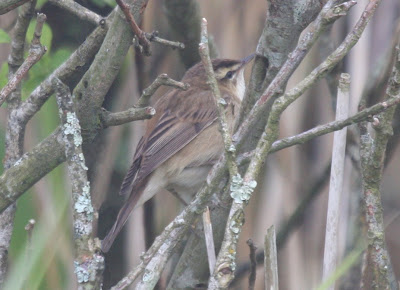
At Treshnish point there was a patch with at least 10 Six-spot Burnet caterpillars many of then feeding on Bird's-foot Trefoil. Bird's-foot Trefoil is the food-plant of the rare Slender Scotch Burnet so I took photographs just to be sure but Slender Scotch Burnet is a a much duller colour.
This White Ermine moth was below Haunn cottages.
14th: There was at least 1 Greylag at Duill pond and possibly the same pair at Haunn and Treshnish lochan.
A Golden Eagle flew from Beinn Duill to Treshnish Point with a white prey item.
13th: A Chiffchaff was singing in Treshnish wood near the House. No more about Chiffchaffs unless they leave or I have proof of breeding which would make a new species for our 10x10km square. A House Martin was seen briefly at Treshnish House.
12th: A Chiffchaff was singing in Treshnish wood near Ensay Burn,
and there was a Spotted Flycatcher nearby,
and I had a quick glimpse of 2 Bullfinches. It was too brief to see their age or sex.
Near Treshnish Point this diver flew past which I think may be a Black-throated Diver, which is supposed to have more extended feet.
A Greater Black-baked Gull tried to steal a fish from a Gannet, kleptoparasitism is the normal behaviour of skuas but black-backs do their fair share too.
The Gannets were a bit far away. A couple of days ago I saw a juvenile (all brown with a white bar across the rump) and this one is almost fully mature.
but at least I got an atmospheric shot (and a beautiful evening).
Inspired by our guests I went to try again for Tawny Owl photos. This was taken at 10pm
I heard one hoot whilst I waited but they are certainly not noisy.
Usual suspects included: A Great Skua
6 Greylags flew over Treshnish House.
There was a Mountain Hare near Treshnish boathouse.
This Red Admiral in Treshnish wood (1 of 2) was demonstrating how it survives predation (if I had not seen it land I would never have noticed it).
11th: In the morning I was told there were 2 Snow Geese to the west of Treshnish boathouse, which flew towards Treshnish Point. They are probably escapes but have a historic connection with here as they are probably from the flock that originally came from Treshnish. They have not been seen here for over 10 years. You can read more here and there is probably an update in the bird list link in the right hand column.
A Corncrake was heard calling 5 or 6 times about every 3 or 4 minutes or so at about 8pm. It was on the raised beach at Treshnish Point, calling from the willow hillside there. Hopefully it will stay there.
At the same time there was a Short-eared Owl in and beside the same field where the Snow Geese were seen and there were also 4 House Martins hawking insects with the Swallows at the cliff there.
There were a few Fulmars at Treshnish Point but the ones visible on the southern side were not on eggs yet.
A rare visitor to Treshnish in the summer was a Greenfinch calling loudly in the wood.
Usual suspects include:
a recently fledged Rock Pipit,
Whinchat

and Black Guillemot.
Guests Tony Gibson and Jayne Calvert saw a Mallard with 14 ducklings at Duill pond.
This caterpillar was found at Treshnish Point. I am pretty sure it is Six-spot Burnet moth. The rare Transparent Burnet is also present at Treshnish, sometimes in large numbers.
One of Treshnish's rare plants, Wood Bitter-vetch Vicia orobus is flowering in Black Park field. This plant is quiet common and flourishing at Treshnish.
10th: At Croig there were 3 terns one of which was an Arctic Terns (my first of the year). Terns presumably breed on the islets there. I originally misidentified this as a Common Tern because of the black bill tip but the tail is longer than the wings and legs are short.

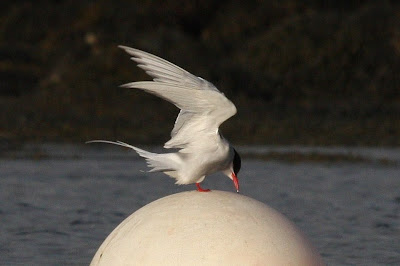
We waited for an hour and a half waiting for it to fly off this buoy and and walked around the harbour to get the light behind us. I was looking for a a good flight shot. Eventually deciding that it may roost here we got up to leave and turned round to see it had flown. As 'Niels Bohr' Leena says 'how do we know if we had stayed it would have also have flown?'.
Also at least 1 Whimbrel
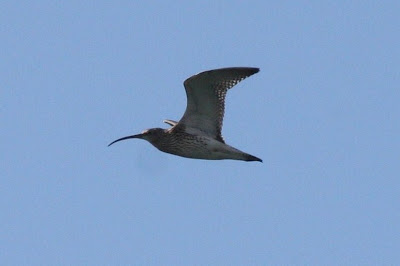
and 1 Bar-tailed Godwit.
I was too concentrated on the Common Tern to get better shots of the Whimbrel and godwit.
A Common Gull nest with eggs was right out in the open near a popular beach there.
Three Greylag adults had 5 goslings (so perhaps the flocks are of males)
Usual suspects included Ringed Plovers in courtship display
1 Dunlin
and a breeding plumaged Great Northern Diver
and at Treshnish Whitethroat.
The 4 Greylags were below Ensay House and 2 Wood Pigeons at Treshnish wood.
Mike Tomlin staying at Shian cottage photographed 1 of the Tawny Owls in the 'Barn Owl' box below the cow-barn! I had almost given up on these owls as they seemed to be so quiet and a couple of evening watches had drawn a blank.
The photo was taken at 9.20pm with 1600 ISO and has been cropped with permission by Prasad.

The Woodland Walk at Calgary must be fantastic right now as the Narrow-leaved Helleborines can be seen from the road and they are huge.
Usual suspects include: Sea Milkwort
9th: I made a mistake earlier (7th) when I wrote that the House Martins arrived at the same time as last year. They arrived at the same date as our earliest record but that was in 2006 and also the same date in 2008! Last year they were first seen here on 18th of May and started nest building on the 3rd of June so it will probably be a couple of weeks before they start nest building.
The 4 Greylags were below Ensay House and there was a flock of 21 at Ulva ferry but no sign of the Brent Goose.
At Ballygown an incubating Meadow Pipit was flushed from its nest almost beneath my feet (I think it was a Meadow Pipit).
Went looking for Spring Squill which a neighbour saw at Balygown several years ago. I didn't find it but I did manage to re-locate some Parsley-piert which the county-recorder had shown me last year. I was helping with her survey of the square (a euphemism for holding the clip-board) and she is so fast I only had time for one shot. I did a bit more botanizing in that square on my own later on in the summer (even my holding the clipboard had slowed here down and we didn't complete the square) and so I had a chance to look for Parsley-piert again but couldn't find it. Here it is
and it is so tiny (my finger-tip for comparison) it must be being overlooked. Now I have to find it at Treshnish.
8th: A Chiffchaff was heard in the wood near Treshnish House and the House Martins were hawking over the wood where there was 1 Spotted Flycatcher (our first of the year and I believe the first for Mull). The latter two are the last two of our regular breeding migrants to arrive and now any more breeding species will be rarities like Corncrake and Quail or passage migrants such as Turtle Dove, Swift and Whimbrel.
The pair of Greylags were both sides of Ensay Burn mouth.

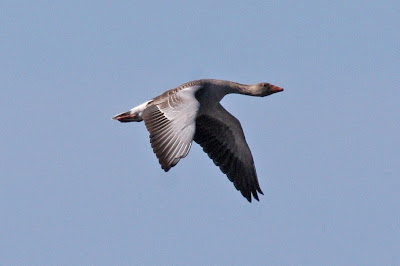
Common Gulls were copulating along the shore below Treshnish House.
There were at least 2 Red Admirals in Treshnish wood.
Very disappointing news today; the flowering Narrow-leaved Helleborine has been badly damaged. It looks like it has been chewed by something. The same thing happened last year but earlier on and so I thought it has passed that danger. I have propped it up but I am sure it won't be able to seed. Two years ago this plant miraculously produced seed when the only nearby plant didn't flower. Pollination from the colony at Calgary and self-pollination seemed like the only possibilities but then last year a third plant was found nearby off Treshnish. I haven't checked this third plant this year but the second plant at Treshnish has not emerged yet. Narrow-leaved Helleborine is fast to develop from a shoot to flower whereas Common Twayblade has been in leaf since at least the 13th April and is still not flowering.
7th: The pair of House Martins at Treshnish House outbuildings arrived back at exactly the same date as last year. They were immediately checking out the old nest.
A Chiffchaff was singing in Treshnish wood so they are definitely staying around and I think I also heard a Bullfinch calling there.
A pair of mergansers flew below Treshnish House but I got only a split second view and same goes for a flash of what I presume to be a Sparrowhawk in Treshnish wood.
Common species which I have no proof of breeding in the Treshnish 10x10km square include Sparrowhawk, Wood Pigeon, Collared Dove, Greylag Geese, Mistle Thrush, Chiffchaff, Blackcap, Greenfinch and Bullfinch. So these species receive special mention in this diary particularly as this is the last summer of entries for the new breeding atlas. Scarcer birds that are also missing proof of breeding include, Red-throated Diver and Golden Plover with an outside chance of Hen Harrier and Merlin. Woodcock and Mistle Thrush were breeding in the previous atlas.
6th: The Jackdaws are still present.
This is one of the Common Gull nests from the colony at Treshnish lochan where there are about 16 pairs.
A Brent Goose was at Ulva ferry (Jayne Calvert and Tony Gibson)
and the 2 Greylags are still around Treshnish wood area.
Usual suspects: Skylark
5th: A pair of Jackdaws were in north-west Mull and they have been present for 3 or 4 days. They are first year birds as they don't have a pale iris, the flight feathers are still brown and one has only the a hint of the pale nape. Jackdaws usually start breeding at 2 years of age and breeding pairs will already be on eggs. They pair for life.
I have never seen it previously on Mull. A pair bred at Dervaig church-tower in 2002 and there were records from Calgary on 1st of June last year and 1st of April 1982. There was also a dot for the Treshnish 10x10km square in The New Atlas of Breeding Birds in Britain and Ireland: 1988-1991 (1993) but this was not from a timed tetrad survey (so presumably a roving record). In The Atlas of Wintering Birds in Britain and Ireland (1986) it was also present in NM34 (Treshnish square), NM44 (Ballygown square) and NM45 (Dervaig square) so presumably it was much more common at that time. I believe it is resident on Iona.
The pair of Greylags are still in the Treshnish wood area.
4th: At least 1 male Chiffchaff still singing in Treshnish wood and 2 Greylag Geese flying from Treshnish lochan to below the wood.
Usual suspects include:
>male Twite

Linnet
Whitethroat
Ringed Plover

At least 2 Orange-tip butterflies along the farm track through Treshnish wood. I got this shot quite quickly and spent ages trying to get a better one.
I like the sun on this Speckled Wood.
At this time of year I get tantalizing views of the overwintering butterflies but I have not yet got their general appearance (jizz). There have been several sightings of definite Peacocks around Treshnish wood this month but a more orange one has been seen a few times which I am unsure of. At Bennan I had a better view of what I think was a Painted Lady (a migrant) and a butterfly at Langamull landed near a nettle patch and simply vanished into thin air at my feet (how do butterflies do this transmogrifying trick). However there was 1 definite Red Admiral in Treshnish wood.
Perhaps you remember the Puss Moths I reared from 6 eggs which were laid in the light trap (5 survived - I kept 3 and gave 2 to friends). It took 2 years for the first 2 to emerge last year and I had given up on the third. You are supposed to be able to hear a rattling sound of a dead pupae if you shake it a little but I wasn't sure. Today I found my last one emerged! Hopefully it hasn't been sitting in that pot for too long (I really had given up on it - but kept the pot just in case).
The pupae case and hole can be seen on the right of the frame. The pupae was glued in between some bark
This is the caterpillar from July 2008 a couple of days before pupation. Other images can be found by clicking the photo and entering the gallery (all photos are viewed better that way

The word Puss is pronounced as in 'Puss and Boots'. This family has similar names: Sallow Kitten, Alder Kitten and Poplar Kitten.
Found my first Large Red Damselfly of the year at Langamull (my earliest by 3 days and as far as I know the earliest record for Mull)
This is my first Four-spotted Chaser (and my earliest record by 8 days).
The first Heath Spotted Orchids were seen flowering at Langamull and no doubt at Treshnish too.
3rd: The male Peregrine was again at the Tobermory church tower. It was there off and on for at least 45 minutes. At one time it dived on a pigeon and nearly caught it. This happened unnoticed a few feet above the heads of some pedestrians.





